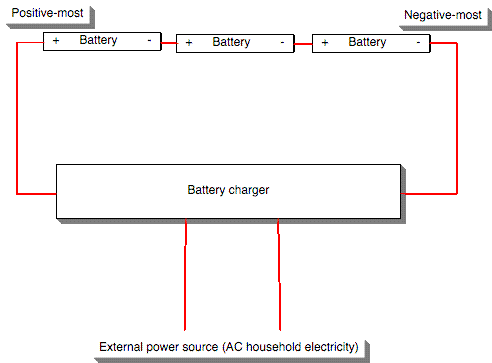Basics of charging battery packs - primary focus on Lead-Acid

(NOTE This is a very old posting (August 2005) I had on 7gen.com which is being copied to here - this needs to be updated with new information TODO)
Batteries are simply a storage means for electricity. They do not in themselves generate electricity, so any electricity coming from a battery has to come from elsewhere.
The electricity is stored in chemical bonds, and it is the battery chemistry which determines the storage capacity (see power density). We don't need to worry over why lithium batteries store more power than nickel-metal-hydride which in turn store more power than lead-acid. That question is best left for the battery experts of the world. Instead we can treat it as a known fact, that different battery chemistries have different power densities, and different charging characteristics.
To charge a battery one simply runs a current through the battery until it is charged. Simple, eh? Well, not quite, because if the charging is done incorrectly the battery can be ruined and may even explode violently. One should take care to charge your batteries correctly.
It's best to buy the correct battery charger for your usage scenario and battery chemistry. Good quality battery chargers know the best method to charge a battery, and test the battery's condition as it is being charged, and always charges the battery properly and to the correct level without overcharging.
Typical wiring for a battery charger

Typically you connect the battery charger to the postive-most and negative-most terminals of the battery pack. These same terminals are also connected to the power controller to send power to the motor.
There may be protection circuits to monitor the pack while charging, to assist with correct charging. You might also use bank charging rather than pack charging. The above picture shows using one charger to charge the entire pack, hence it is pack charging. Bank charging works differently by using one charger per battery. Bank charging is one of the ways of achieving a balanced battery pack.
Balanced battery packs
Battery packs are best when the cells are "balanced", meaning that the batteries in the pack are at the same voltage throughout the entire discharge and charge cycle. Unfortunately batteries are analog devices and each one is slightly different in the same way that you might use the same recipe to bake cookies every week, and still end up with different results from week to week. When batteries in a pack are unbalanced the ones with less voltage cause the neighboring batteries to do more work. This results in greater stress on the batteries which results in a shorter useful life for the pack.
Bank charging
Bank charging is one of the ways to achieve a balanced pack. In bank charging there is one charger per battery in the pack. Assuming each charger behaves exactly the same as the other chargers, this will tend to charge each battery equally. Thus the battery pack should be balanced once it is fully charged.
It's been observed that batteries in a pack do not have equal voltages during discharge. For example often the negative-most battery will have a lower voltage than the other batteries.
Battery regulators, battery balancing, and battery management
A battery management system (BMS) is circuitry which monitors batteries and moves charge between the batteries to keep them balanced. A BMS unit can be thought of as a mini-battery-charger. The BMS circuit detects differing voltage in neighboring batteries, will discharge the battery having the higher voltage and directing it into the one having the lesser voltage.
Charging Lead-Acid batteries
http://batteryweb.com/charger.cfm is a page constructed by a vendor of batteries and chargers, they have a long list of battery charger brands. http://batterymart.com/c-battery-chargers.html is a similar page at a different vendor. Ditto with http://batterystuff.com/battery-chargers/12-volt/, and http://batteriesareus.com and http://jcwhitney.com/Battery-Chargers and http://boatandrvaccessories.com/BATTERY-CHARGERS.htm
Power-Sonic File downloads contains a lot of useful information by one of the manufacturers of sealed lead-acid batteries, Power-Sonic. Their Technical Manual is truly excellent.
B.B. Battery Valve Regulated Lead Acid Battery Manual
Zivan USA - Makers of a highly customizable battery charger. It is computer controlled to have any charging "algorithm" allowing it to be used for "any" battery type.
Soneil - A leading maker of chargers for lead acid batteries. Their charger has frequency characteristics they claim desulfates batteries, leading to improved life.
www.accelrate.com - "AccelRate’s charger technology utilizes a charge/discharge algorithm that enables a full state-of-charge in 80% less time than conventional technology, and will extend battery life to its original capacity because of heat reduction during charging." Their chargers work not only with lead-acid, but also Ni-CD, Ni-MH, and Lithium batteries.
Battery Tender makes a line of chargers meant for "float" use. Float charging of SLA batteries is done for long term maintenance. Batteries, sitting idle, tend to leak power and tend to degrade.
Battery Life Saver offers interesting claims of SLA battery maintenance. It's been observed SLA batteries will have sulfur buildup, and some chargers claim to have special characteristics that diminish the sulfur buildup.
Black & Decker make a series of battery chargers that are also available under the Vector brand name. They have good features for properly charging sealed lead-acid batteries.
Charging Nickel-Metal-Hydride (NiMH) batteries
www.accelrate.com - "AccelRate’s charger technology utilizes a charge/discharge algorithm that enables a full state-of-charge in 80% less time than conventional technology, and will extend battery life to its original capacity because of heat reduction during charging." Their chargers work not only with lead-acid, but also Ni-CD, Ni-MH, and Lithium batteries.
Charging Lithium-ION batteries
www.accelrate.com - "AccelRate’s charger technology utilizes a charge/discharge algorithm that enables a full state-of-charge in 80% less time than conventional technology, and will extend battery life to its original capacity because of heat reduction during charging." Their chargers work not only with lead-acid, but also Ni-CD, Ni-MH, and Lithium batteries.
Who's online
There are currently 0 users online.
Who's new
- eric01
- Norberto
- sarim
- Edd
- OlaOst


